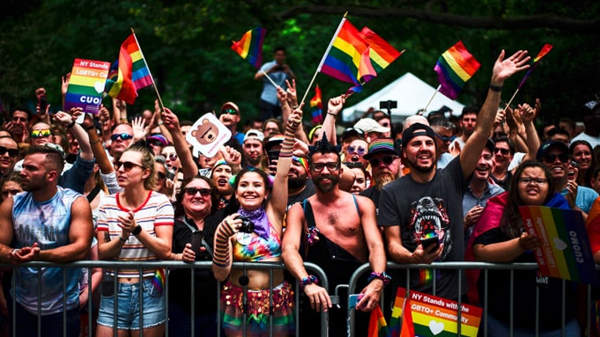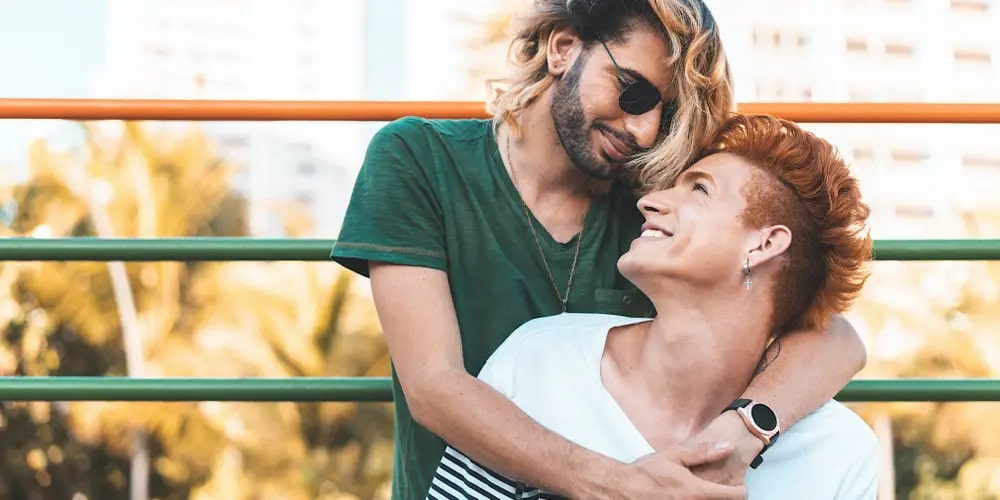Pansexual vs Bisexual: Differences Between Pansexual and Bisexual Orientations
ALL TOPICS
- Child Monitoring Apps
-
- Best iPhone parental monitoring apps
- Best free phone monitoring apps
- Android monitoring apps to monitor your kids
- Android network monitoring apps
- Discord Monitoring Tips
- IPhone parental monitoring apps
- IPhone baby monitor apps
- Sleep tracking apps for iPhone apple watch
- Snapchat monitoring apps that really work
- CreepyPasta-Scary Stories Kids Read Online
- Snapchat Monitoring
-
- How to monitor Snapchat for free?
- How to monitor Snapchat on iPhone for free?
- How to monitor Snapchat remotely or without their phone
- Useful ways to monitor Snapchat without jailbreak
- Snapchat tracker how to track on your kids Snapchat
- Use Snapchat tracker to track on your kids' Snapchat
- How can parents monitor Snapchat?
- Other Tips of Child Monitoring
Sep 11, 2024 Filed to: Parent's Guide Proven solutions

If you’ve encountered multiple terms like pansexuality and bisexuality on the web, you’re probably wondering what those words mean. In the omnisexual world, people use those terms to express their sexual tendencies.
Both terms help people identify themselves with their sexual orientation and romantic preferences. However, these terms mean two different things. Pansexual people feel attraction toward people of all genders, whereas bisexuals feel attraction toward two or more genders.
With such varying definitions, these concepts can easily become vague. Read on to learn more about sexual orientations, pansexuality, bisexuality, and their main differences and misconceptions.
Table of Content
- Part 1: Sexual Orientations Explained
- Part 2: What Is a Pansexual?
- Part 3: What Is Bisexual?
- Part 4: Pansexual vs Bisexual: Main Differences

- Part 5: Misconceptions About Pansexuals and Bisexuals
- Part 6: Pansexual vs Bisexual: How To Recognize
- Part 7: How to Talk to Your Kids About Their Sexuality
- Part 8: How To Make Sure Your Child Is Exploring Their Sexuality Safely

Part 1: Sexual Orientations Explained

Your sexual orientation defines who you want to have a relationship with. It is the depiction of your sexual and romantic preferences. There are many sexual orientations today, such as asexual, bisexual, straight, lesbian, gay, etc.
Sexual orientation differs from gender identity and is all about who you feel drawn to sexually, emotionally, and romantically. If you’re attracted to a different gender, you’re straight or heterosexual.
On the other hand, if you feel attraction toward the same gender, you’re homosexual or gay. If both men and women are attractive to you, you’re bisexual. However, people who feel attraction toward others regardless of gender call themselves pansexual.
You are free to choose your sexual orientation according to your feelings. You can identify with one or more types of sexuality or change your orientation over time.
Keep in mind sexual orientations differ from romantic orientations as the latter revolves more around experiencing romantic attraction instead of purely sexual desire. Just like you can be pansexual or bisexual, you can also be biromantic or panromantic.
Part 2: What Is a Pansexual?

The easiest way to understand pansexuality is to describe it as an attraction to people from all genders. As a pansexual, you can be attracted to one or several genders across the gender spectrum. However, pansexuality goes well beyond gender-based attraction.
In other words, you’re not limited to gender itself per se but feel attraction toward all genders and all individuals. Still, different people explain their pansexuality differently. That’s why you should be open-minded toward all people who choose to avoid taking gender into account when considering attraction.
Part 3:What Is Bisexual?

Identifying as bisexual means you might express romantic, emotional, or sexual attraction to people of more than one gender or sex. Bisexuality is an inclusive and broad term that people use to describe sexual behavior, romantic preferences, and physical attraction that includes more than one sex.
You should avoid a common misconception about bisexual people that bisexuals are attracted to only females or males. You can be bisexual and still feel attraction to people who identify as nonbinary, transgender, gay, you name it.
Part 4: Pansexual vs Bisexual: Main Differences

Both bisexuality and pansexuality experience attraction to more than one sex or gender identity. The main difference is that bisexuals may favor some genders over others, whereas pansexuals can show equal affection for any sex, gender identity, or gender.
The problem here is that both terms share a broadly similar definition. While you can identify as pan and bi, you can also prefer one over the other. Why? Because you don’t want to complicate things.
For example, you can be attracted to the same or other genders as a bisexual. However, you don’t share affection for all genders. On the other hand, bisexuality has been around forever and has a very long history.
Identifying yourself as bi can be about your connection with the bisexual community. Then, you might prefer identifying as a pan to let others know you like all genders. That would make things much easier, especially when communicating your sexual and dating preferences to others without getting specific.
Part 5: Misconceptions About Pansexuals and Bisexuals

Although both sexual orientations come with common misconceptions, some of them tend to overlap, such as:
- It’s just a phase – many people, especially heterosexuals, will mistake your sexual orientation for just a current phase or fad. They see other sexual orientations as something temporary that will probably change soon. However, you know they are wrong because your sexual orientation may stay with you for the rest of your life.
- Pan and bi are the same things – since identifying yourself as pan or bi is so specific to you as a person, some people may wrongly interpret your orientation or even mistake pan for bi and vice versa.
- Queerphobia – if you’ve just recently admitted to yourself that you’re bi or pan, you’ve probably experienced some stigma about it. Many people see pansexuals and bisexuals as people afraid of coming out as gay. The thing they don’t understand is that each sexual orientation is specific and unique to each person. You can identify yourself as bi or pan and not be gay.
- Promiscuity – this misconception comes from the idea that pansexuals and bisexuals are simply attracted to everyone who crosses their path. However, that’s not true, especially when it comes to bisexuals.
Part 6: Pansexual vs Bisexual: How To Recognize

If you find it difficult to tell pansexuals from bisexuals, look for the following signs:
- Attraction to males and females – if you feel affection for both men and women, you’re most likely bi or pan.
- You feel nervous around your own gender – if you can’t seem to relax around people of your own gender, you’re probably bi. You just didn’t come to terms with your identity yet.
- You often have sexual fantasies about your own gender – if you often find yourself fantasizing about sexual or romantic relationships with people of your own gender, you’re probably a bisexual. However, remember that pansexuals can also like people of their own gender.
- You wholeheartedly accepted bisexuality – if you’re all for bisexuality, then things are more than clear.
- You don’t mind being in a relationship with both guys and girls – you can be bi or pan and see yourself in a relationship with a man or a woman.
- You can’t decide whether you like men or women – while bisexuals may find both men and women attractive, that’s not the case with pansexuals. If you’re a pan, you may find yourself attracted to all people.
- You find androgyny attractive – both pansexuals and bisexuals find androgynous people attractive. If that’s the case with you, you may be on to something here.
Part 7: How to Talk to Your Kids About Their Sexuality

If you need help with talking to your kids about their sexuality and sexual preferences, here are some ideas to get you started:
- Create a safe space to encourage your kids to be who they wish to be;
- Show support for your kid’s unique experiences and praise them for being open with you;
- Accept that there are things about your kids you won’t understand right away;
- Don’t take things personally, as this isn’t about you;
- Allow your children to chase their dreams and be their authentic selves;
- Coming out can be stressful enough for a child, so don’t make things more complicated than they have to be;
- Tell your kids that they’ll always be your kids no matter what happens to encourage them to stay engaged in other life activities;
- Your kids are more than their gender identity or sexual orientation;
- If your child admits their sexual preferences to you, do not disclose that information without their permission;
- Don’t push your kids to tell you sensitive things.
Wait until your child is comfortable bringing their sexuality up on their own. That’s a clear sign that your child is ready to have a meaningful conversation about their sexual orientation and everything else it entails.
Part 8: How To Make Sure Your Child Is Exploring Their Sexuality Safely

In this internet-driven world, your kids probably spend a lot of time online. If there’s something they want to learn about, they’ll turn to Google for information. The same goes for their natural curiosity regarding exploring sexuality.
Since your kids will turn to the internet to explore different sexual orientations, you should find a way to safeguard your kids online. Wondershare FamiSafe is a parent-friendly parental control app that allows you to take control of your kids’ online activity.
The app packs top-grade parental control tools that empower you to control screen time, monitor your kid’s online activities, track their location, and prevent them from consuming inappropriate content.
You can use the FamiSafe app to limit your kid’s time on TikTok, filter the content they browse, limit their phone usage, and remove any explicit content or inappropriate photos from their devices.
With FamiSafe, you get an all-in-one parental control app to keep your kids safe on the web. Do you know what the best part is? You can test FamiSafe for free to see how it matches your parenting needs.
- Web Filter & SafeSearch
- Screen Time Limit & Schedule
- Location Tracking & Driving Report
- App Blocker & App Activity Tracker
- YouTube History Monitor & Video Blocker
- Social Media Texts & Porn Images Alerts
- Works on Mac, Windows, Android, iOS, Kindle Fire, Chromebook
Conclusion
Though they may appear similar, pansexuality and bisexuality are two different concepts. Pansexual and bisexual aren’t the same, nor do they imply the same sexual, emotional, and romantic preferences.
While both sexual orientations share affection for people of more than gender, pansexuals differ from bisexuals by being attracted to every gender. Bisexuals, on the other hand, are attracted to more than one gender.
Though their romantic, sexual, and emotional attraction may spark up at some point, that’s not always the case. In most situations, experience helps shape your sexual identity.

Moly Swift
staff Editor